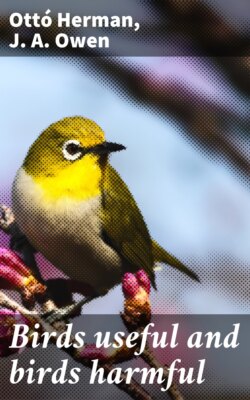Читать книгу Birds useful and birds harmful - J. A. Owen - Страница 9
На сайте Литреса книга снята с продажи.
The Tawny or Wood-Owl.
(Syrnium alúco.)
ОглавлениеTable of Contents
The Wood Owl, known also as the Brown or Tawny Owl, has the admirable trait of constancy, for it is said he mates for life and the pair return year after year to the same tree to nest. In the month of September you will hear him hooting in the woods more than at any other time of the year. He is not so constant in his choice of locality, but like many other birds he and his kind will disappear from a district without any apparent reason, to return to it again after a time. No doubt they follow their food supply; the small creatures they feed on—mice, rats, shrews, and squirrels—all disappear in the same fashion to re-appear elsewhere; the movements of these being no doubt ruled by the same conditions of suitable food, its scarcity or its plenty.
In spite of persecution the Tawny Owl is still fairly common in our own country wherever there are woods or crags suitable for its habitat. In the South of Scotland it is common, as well as in England and Wales. It is strange that it seems to be absent from Ireland. Here, in Ealing, where the present writer lives, its whoo-hoo, or, as Shakespeare has it, tu-whit and to-who, are heard regularly in one little spinney at the south-east corner of our suburb; and last summer—1908—a pair took up their abode in a garden, right in amongst the shady roads not very far from the Broadway.
The Tawny Owl breeds early; strong-flying young ones may be seen in April. A hollow oak tree or an elm is a favorite nesting site with it. The young are
USEFUL.
THE WOOD OR TAWNY OWL.
very easy to rear and to tame. The late Lord Lilford, who was perhaps our best authority on owls, stated that he had examined many pellets of the Tawny Owl, and although he more than once found the remains of young rabbits he could not accuse the bird of any serious poaching.
Living more in the woods the Brown Owl is less often observed than is the White Owl; also its plumage is darker, and this makes it often less visible, especially in the shade of the trees. When flying, his legs are stretched out behind, “as a balance to his heavy head,” White of Selborne remarked. The young ones, funny little balls of grey down, resemble, some one has said, “a pair of Shetland worsted stockings rolled up, such as might have belonged to Tam o’ Shanter.”
And this reminds us of Burns, who, when he bids the birds mourn for him, “Wha lies in clay, Wham we deplore,” sings:
“Ye howlets, frae your ivy bow’r,
In some old tree or eldritch tow’r,
What time the moon wi silent glow’r,
Sets up her horn.
Wail through the dreary midnight hour
Till waukrife morn.”
But Shakespeare said of the Wood-Owl:
“Tu-whit! tu-whoo, a merry note
hile greasy Joan doth keel the pot!”
It was in 210 pellets of this species that Dr. Altum found the remains of 6 rats, 42 mice, 296 voles, 33 shrews, 48 moles, 18 birds, and 48 beetles, besides countless numbers of cockchafers.
Brown Owls make very amusing pets and they are not hard to tame. They are less suspicious than other owls and become very companionable. R. Bosworth Smith, whose recent death was so much lamented by all bird-lovers, and who said: “Birds have been to me the solace, the recreation and the passion of a life-time,” told of one young brown owl which he brought up from the nest, which was very fond of music. It would make its way, through an open window on the ground floor, into the room in which a piano was being played and would even press closely against the case of the instrument. Dr. J. Cooper, Professor of Greek Language and Literature at Rutger’s College, New Brunswick, also told the same author that one morning in November of 1899 he found, on going to his lecture room, that a brown owl had somehow made its way into it, and had selected as a perch a huge framed photograph of Athens. It was, he remarks, an unlooked for illustration to both teacher and taught, of the proverbial expression “Owls to Athens.” And there she was, just over the Areopagus, the High Court of Athens, and she sat perched there four whole hours, that “bird of wisdom,” whilst the Professor gave as many lectures to successive classes of his pupils, quite undisturbed by the noise they made, coming and going. Before she disappeared, one of the lecturer’s brother-Professors had time to take a photograph of “the Bird of Pallas on her chosen throne.”
Description: In the adult male the upper parts are of variable shades of ash-grey, mottled with brown; there are large white spots on the outer webs of the wing-coverts; the tail is barred with brown and tipped with white; the under-parts are a buffish-white, mottled with pale and streaked with dark brown. The disk about the face is greyish, having a dark brown border; the legs are feathered to the claws. The length of the bird is about 16 inches. The female is larger than the male and its plumage is a more rufous brown; but there are two varieties in this species, a red and a grey, the colour being independent of sex; the rufous form is more common in Great Britain. After the first greyish down of the nestlings they put on a more reddish brown than the adult birds have.
USEFUL.
THE LONG-EARED OWL.
